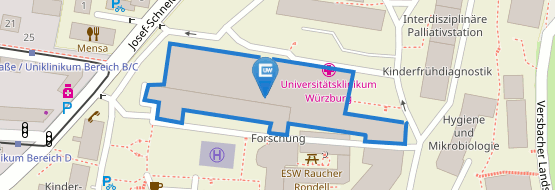ERC Advanced Grant: 2.5 Million Euros for Tobias Brixner
04/11/2024Würzburg-based physical chemist Tobias Brixner has been awarded an ERC Advanced Grant for his pioneering work on multiple electronic excitations. He already received an ERC Consolidator Grant in 2013.

Many people are familiar with the principle of electronic excitation from their physics lessons: electrons in atoms or molecules absorb energy, typically from light, and rise to a higher energy level. This can have various consequences – in photovoltaic technology, the phenomenon ensures that electricity can be generated from sunlight.
Measuring electronic excitation according to scientific standards and investigating how excited electrons influence each other is a real challenge: “Electronic excitation and the subsequent processes take place extremely quickly, many things happen simultaneously“, explains Tobias Brixner, Chair of Physical Chemistry I at the University of Würzburg (JMU) and also a member of the Faculty of Physics and Astronomy. “The scheme of femtochemistry is well established in research: a molecule is excited by a short flash of light and the temporal change is observed by a delayed second flash of light – as in an extreme slow-motion recording. The flashes last only a few femtoseconds, i.e. millionths of a billionth of a second.“
Despite the many successes of this technology, it is not yet possible to clearly understand the many interactions between multiple excited electrons. Key quantum phenomena remain poorly understood. Brixner and his team are therefore developing new experimental investigation methods.
From Theory to Application
Recently, Brixner and his collaborators at the University of Ottawa, Canada, developed a new approach to separate the individual contributions of single, double and multiple excitations without overlap for the first time. The researchers demonstrated the method on polymers from the Institute of Organic Chemistry at JMU, as well as on other molecular and biological systems. Brixner reported the results at the 2022 Nobel Symposium for Chemistry in Båstad, Sweden, followed by a publication in 2023 in the renowned scientific journal Nature using the example of the “transient absorption“ method.
“The idea of systematically breaking down complex physical processes into more comprehensible individual effects has been known for a hundred years in the context of perturbation theory“, explains Brixner. “Now the concept can also be implemented experimentally in a very simple way.“
The new approach works like this: the molecule is excited with a series of different laser intensities and the time-dependent evolution is observed. At high intensities, there is a high probability that the molecule will be excited twice, three times or even more – at lower intensities, single excitations dominate. By combining all the observations mathematically, the researchers are able to separate the individual contributions not only qualitatively but also quantitatively. This finding, surprising even to experts at the time of publication, is the core principle of the new project.
About the IMPACTS Research Project
The idea will now be extended to other spectroscopic methods and combined with microscopy to obtain information about the interaction of excited states in molecules and materials with temporal and spatial resolution.
The new funding will enable Brixner's team to pursue their research intensively over the next five years. The European Research Council (ERC) has now announced that Brixner will receive an ERC Advanced Grant – an award worth 2.5 million euros for his project “Isolating Multi-Particle Correlations in Time and Space (IMPACTS)“.
This makes Brixner one of the few researchers to have received an ERC grant twice. In 2013, he received an “ERC Consolidator Grant“ (totalling 2.7 million euros) for the career phase between six and twelve years after the doctorate, and now the new prize in the competition for excellent research ideas at all career phases.
About the ERC Awardee
Tobias Brixner has held the Chair of Physical Chemistry I at JMU since 2007. He studied physics in Albuquerque (New Mexico, USA) and Würzburg and received his PhD in 2001 with experimental physicist Gustav Gerber. After a postdoctoral period at the University of California in Berkeley with chemist Graham Fleming (2003 and 2004), he returned to JMU to lead an Emmy Noether junior research group funded by the German Research Foundation (DFG).
Among other things, Brixner has been speaker of the DFG research group “Light-Induced Dynamics in Molecular Aggregates“ (2012 to 2019), dean of the Faculty of Chemistry and Pharmacy (2021 to 2023) and general chair of the “International Conference on Ultrafast Phenomena“ (2024), the largest conference in the field of ultrafast phenomena.
In the field of new digital teaching concepts, Brixner is also developing the award-winning virtual laser laboratory “femtoPro“, which allows students to learn practical work with laser radiation in an eye-safe manner.
Second ERC Awardee from JMU
Professor Bernhard Nieswandt, chair of Experimental Biomedicine I at the University Hospital of Würzburg (UKW) and Research Group Leader at the Rudolf Virchow Centre of JMU, has also received an ERC Advanced Grant for his research on blood platelets. The funding for his "PITT-Inflame" project, which focuses on platelet research, amounts to 2.5 million euros. (press release)
Contact
Prof. Dr. Tobias Brixner, Chair of Physical Chemistry I, University of Würzburg, T +49 931 31-86330, tobias.brixner@uni-wuerzburg.de


